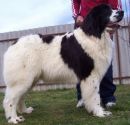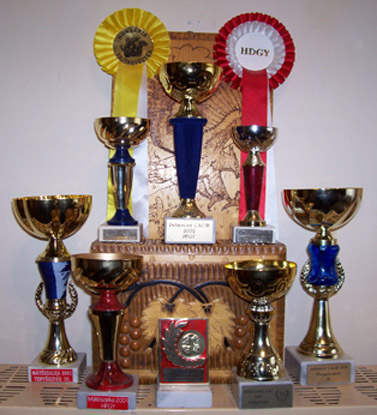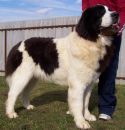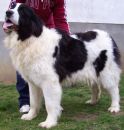

| Gem of Jéke Kennel |
| Landseer Kennel |
| Breeder: István Takács Address: 4611 Jéke, Fő út 29. Mobile: +36-20-800-92-12, Tel/Fax: +36-45-403-506 E-mail: jekekincse@freemail.hu |


| Landseer History |
|
Newfoundland is not a welcoming island. Summers are short and stormy, and in the long and frosty winters, daylight lasts for only a few hours. The fearless and determined first settlers of the island, who may have been the Vikings, or French, Spanish, Dutch or English sailors who somehow managed to make it through to the cliffs on the edge of the island, stayed only for a short while. Eventually, it was a handful of Beothuk Indians who decided to settle on the island for good in the late-15th century, when the English claimed title to the island. It is not known whether there had been any dogs living on the island before the first settlers arrived. What is known, however, is that the so-called Indian Dogs, which were native to the neighbouring Canada, were black-and-white breeds. The assumption that the dogs were carried to the island by the Beothuks is, therefore, not without grounds. Or it may have been the Normans who landed on the island around 1000 AD that left behind a few dogs. According to another theory, the first dogs belonged to the English or French troops who fought for Newfoundland in the year of its discovery (1497). In 1713, the Utrecht peace treaty awarded the island and the surrounding sea, which teemed with fish, to Britain and Newfoundland became the permanent residence of fishermen and timber-merchants. In the late-18th century, travellers of the sea took the first dogs from Newfoundland to Great-Britain. The sailors told wonderful stories about the black-and-white and large, yet not clumsy, “bear dogs”: how they dived off the cliffs and swam towards the fishing boats. With a rope held between their teeth, the dogs were even able to tow boats to the shore. The Brits were amazed to hear how the dogs, which fed only on leftovers of fish, were capable of pulling the fishing nets to the shore and even carrying the loads of Eskimo Indians. The newly discovered super dog was a huge hit with the dog lover Brits, especially the nobility. The dogs were more prolific in Europe than in their native land, where many of them fell victim to the long and cold winters and famine, and the harsh climate also adversely affected them. The young and weak animals did not have a chance to survive because although the locals used the dogs, they were reluctant to take care of them. Soon, the dogs would become a major source of income, yet the islanders were unable to keep up with the increasing demand for the dogs. Eventually, the dogs got extinct in their native land. The English began to breed the huge dogs (with a height of 90 cm at the withers, the Newfoundland was the largest dog). They probably tried to cross-breed the dog with other breeds in order to achieve the desired strength and size. By the mid-18th century, Newfoundlands were found on every estate and became popular models of painters, including Sir Edward Landseer. The dogs were named after him, their most devoted admirer, because of his painting titled The Distinguished Member of the Human Society, which features a Newfoundland dog. Soon, the dogs became popular in continental Europe, too, especially on large estates. The dogs were known there as Landseers. In the mid-19th century, sailors discovered another variety of the Newfoundland dog on the island: this one was clear black, somewhat smaller than the bicolour variety, and also had webbed feet. Soon, the newly discovered black dogs became more popular than the black-and-white variant. For almost sixty years, the old variant, which was discovered, bred and popularized by the English, was forgotten. When after World War I European breeders again wanted to breed black-and-white Landseers, they had a hard time finding a few remaining dogs in Germany and Switzerland. They cross-bred the clear black and the surviving black-and-white varieties, and in about half a century, they managed to breed the original Landseer variety, which was recognized as an independent breed by the FCI in Brussels in 1960. This continental European breed originated from Germany/Switzerland. In these two countries, and also in France and Austria, these dogs are bred as a separate breed, and they are not allowed to be cross-bred with clear black or brown Newfoundland dogs. In England, the Netherlands, Scandinavia, and the American continent, Landseers are considered the black-and-white variant of the Newfoundland breed, and they are cross-bred with clear black and brown Newfoundland dogs. It is not surprising, therefore, that this type is fairly rare. Landseers do not belong to flats because they are rather demanding. They first and foremost need space. With a height of 80 cm at their withers, they belong to large dogs despite the fact that they are not heavy-weight. They need a lot of exercise, not only on a lead, but also freely. A person who has a Landseer must have a lot of free time: the active dogs are not satisfied with just short walks. They prefer long hikes which possibly include some swimming. Water is their favourite, regardless of the time of year. Just like their ancestors, they are able to swim against the tide, dive and retrieve. They are happy to splash about even if the water is not crystal-clear, which, however, calls for a thorough cleaning procedure afterwards. Landseers are aware of their size and immense power. If the owner does not cooperate with the dog, he is about to face difficulties during the training. If kept on a lead, the dog may easily drag the owner who is not strong enough. The dog is keen on wrestling the owner to the ground if he fails to train the dog in time not to jump up. Like most large-size dogs, Landseers are not aggressive. When provoked by people or animals, they stay calm, but when they get really annoyed, they are hard to be restrained. Landseers are independent dogs. They like to make independent decisions without relying on their masters. Owners who give the dogs sufficient freedom without spoiling them and accept their temperament will experience that these dogs are ideal protectors of children, excellent playmates of youngsters, and alert companions of adults. Landseers are not guarding dogs, and it is not recommended to train them to be aggressive because they may pose serious danger. People who love hot climate and prefer fireplaces to cold weather will not be happy with a Landseer. The dogs love the outdoors and are in their element when the temperature is around zero degree. During hot summer days, they like to lie in a cool corner of the house and daydream about the chilly northern climate.  Opening page >>>>> Opening page >>>>> |





| Breed history |